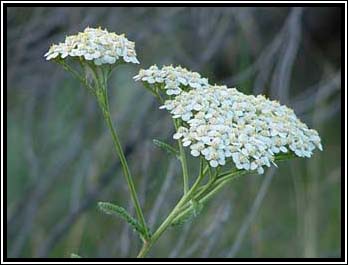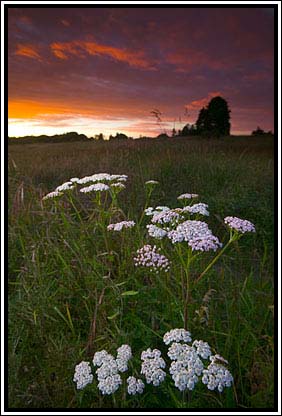|
ECOLOGY
Achillea lanulosa is a perennial weed considered invasive in many parts of the Northwest. Identifiable by its many green, feathery, fern-like leaves, fuzzy stalk, it can grow to be 1-3 feet tall and has fifty or more whitish flower heads that are flat or domed in clusters. It typically grows in sunny lawns and fields, and along edges and roadsides. It requires a well-drained soil and actually enhances the essential oil content of surrounding plants, improving their health. Yarrow is harvested between June and September. The young plant has the highest potency, and while people use the whole herb, the more potent flowering tops are generally the most potent part and are used most often. It is used in beauty products like lotions, sunscreens, facial cleansers, astringents, and shampoos. Medicinally, it is put into cold mixtures because it regulates body temperature. Homeopathic uses include herbal extracts and teas, herbal baths, and ointments to help with body pains, muscles, and joint relief.
|
|
HISTORY
Yarrow has a long history in many cultures to stop bleeding and as an anti-inflammatory. Achillea, its genus name is thought to be derived from the Greek hero Achilles who carried yarrow into battle to heal wounded soldiers. Millefolium means in Latin, “Thousand Leaves,” which describes the foliage of the plant. It was used in ancient European battle fields to stop bleeding wounds. It was also boiled to form a wine and drunk as a remedy for excessive menstrual cycles. Also a very significant plant in Chinese culture, yarrow was considered a beneficial herb in improving respiration, and skin and muscle tone. |
HISTORY
Yarrow has a long history in many cultures to stop bleeding and as an anti-inflammatory. Achillea, its genus name is thought to be derived from the Greek hero Achilles who carried yarrow into battle to heal wounded soldiers. Millefolium means in Latin, “Thousand Leaves,” which describes the foliage of the plant. It was used in ancient European battle fields to stop bleeding wounds. It was also boiled to form a wine and drunk as a remedy for excessive menstrual cycles. Also a very significant plant in Chinese culture, yarrow was considered a beneficial herb in improving respiration, and skin and muscle tone.
|
|
ECONOMICS
The most demand on the market for yarrow is in medicinals, due to the high volume of remedies it is used in. Herbalists and people into homeopathic remedies construct most of the gathering market in the U.S. Yarrow is also harvested in Europe where it is sold for $4.00/pound. Here in the United States it is commonly sold for about $10.00/pound. I expect that exports are high in Europe as many Americans might want to get the lower prices from Europe. Typically the market process starts with harvesters who have gathered the Yarrow from the wild sell it to a vendor who then sells to the company buyers, where the product then enters the market. Each stage in this commodity chain adds value to the plant.
MANAGEMENT AND POLICY
There are no restrictions for the gathering of yarrow on private property by the owners of the land. In the Willamette National Forest permits are required to harvest commercially and for personal use. The permitting system helps to sustain populations of Yarrow as well as other species in the surrounding area. Yarrow is not threatened but it is illegal to harvest in protected areas. The United States Department of Agriculture also has restrictions on harvesting plants in the wild; therefore it is important to check for restrictions with the manager of the land on which you plan to harvest.
*Compiled from a paper by Erin Yaru |
|


